Master Recipe from Gluten-Free ABin5
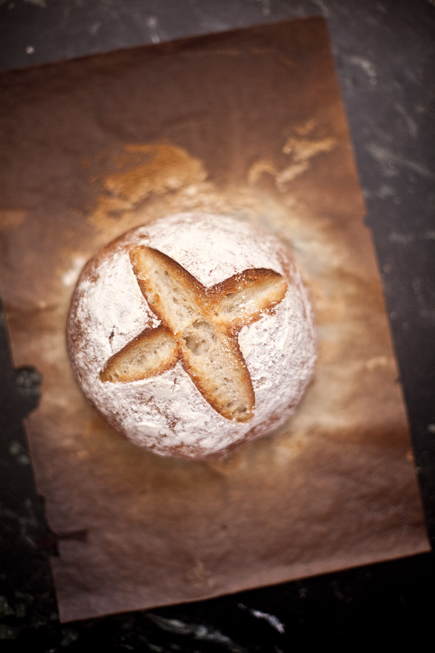
The idea for a gluten-free version of The New Artisan Bread in Five Minutes a Day started here on the website. People were writing in to say they loved the method, but couldn’t eat wheat. It set off a quest to develop recipes that fit this fast and easy method but used flours that were gluten-free. Gluten-free breads have appeared in all of the books since then, but they were just small chapters among a bunch of wheat filled recipes. It seemed unfair to the folks who couldn’t eat wheat to buy a book filled with recipes that didn’t suit their needs, so… a book just for them. Last week Gluten-Free Artisan Bread in Five Minutes a Day came out–here is its Master Recipe.
There’s been great feedback from the original gluten-free recipes, but what you see here is even further simplified. That meant developing two flour mixes that all our recipes are based on, so you just have to mix the flour once for many loaves. You just mix up a big batch of our Gluten-Free All-Purpose Flour Mix and/or our Whole-Grain Gluten-Free Flour mix and you’ll be able to quickly mix and bake all 90 gluten-free artisan bread recipes in our book. (Commercial flour mixes haven’t worked well for breads made from stored dough).
I also wanted to provide recipes that are mostly vegan (no eggs) and dairy free. Because eggs are a leavening ingredient, we do like the Master Recipe made with eggs for a lighter loaf. In fact, we find that the dough made with egg whites is the lightest of all the options. You can also use an egg substitute if you choose not to use eggs. And as always with the method, you save time by mixing a large batch and storing it in the refrigerator, pulling off dough to use as you need it.

The following recipe is the Master Recipe from GFABin5 made with egg whites, but you can make the same recipe with whole eggs, egg substitutes or without any eggs at all.
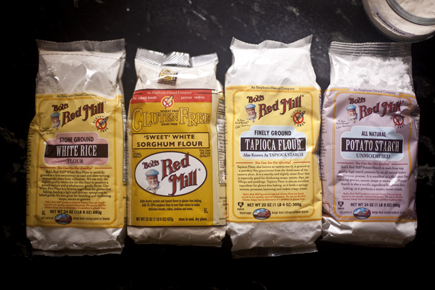
Gluten-Free Master Recipe from Gluten-Free Artisan Bread in Five Minutes a Day on page 64, and the egg variation can be found on page 73). For a video of this recipe’s steps that’ll open in a new window, click here):
6 1/2 cups (2 pounds 3 ounces / 990 grams) flour mixture #1 from the book, which is reprinted at this link. We tested all our recipes with Bob’s Red Mill unblended flours, not their gluten-free flour mixtures.
1 tablespoon Red Star Active Dry or Quick Rise yeast (not Red Star Platinum, which isn’t gluten-free)
1 to 1 1/2 tablespoons Kosher salt
2 tablespoons sugar or honey (we find that the gluten-free dough needs the sugar to brown nicely, although it is optional)
4 egg whites, plus enough warm water to equal 3 3/4 cups (*see picture below) – if you don’t want to use eggs, then just use 3 3/4 cups water.
To mix the dough:

*Put 4 egg whites in a large measuring cup, fill the cup with water until you have 3 3/4 cups liquid.
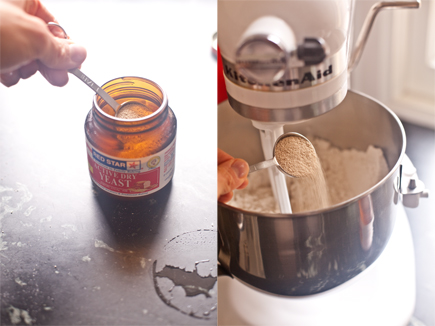
I suggest using a Stand Mixer with the paddle attachment for the smoothest dough and ease of mixing. You can still do the mixing in a bucket or bowl, as recommended in the past books, but it will take a bit more effort to get a really smooth dough.
In a stand mixer, fitted with the paddle attachment, add the yeast to the flour mix #1. The recipes were tested with both Active and Quick Rise yeast from Red Star and they work equally well in stored gluten-free dough. You can’t use their Platinum yeast, since it contains trace amounts of wheat.
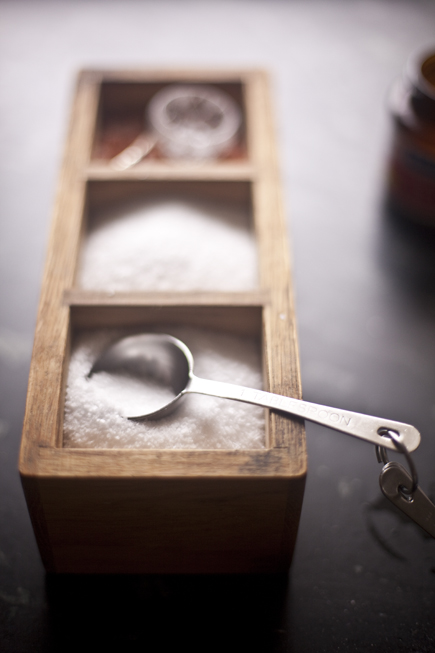
Add the Kosher salt and the sugar (if using) to the flour mix. You can add more or less salt, depending on your preference.
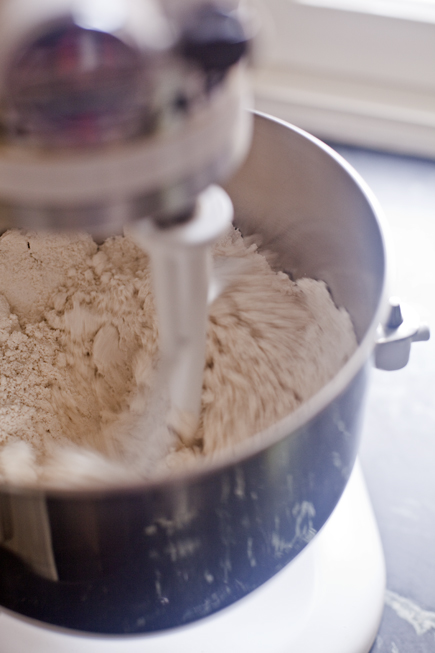
Blend all the dry ingredients for a few seconds.
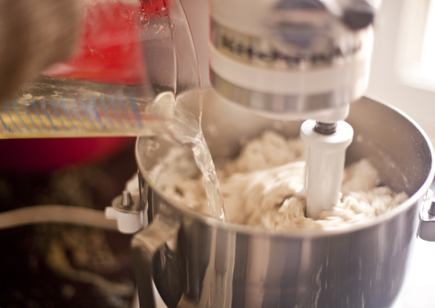
While the mixer is on low speed, slowly add all the liquid.
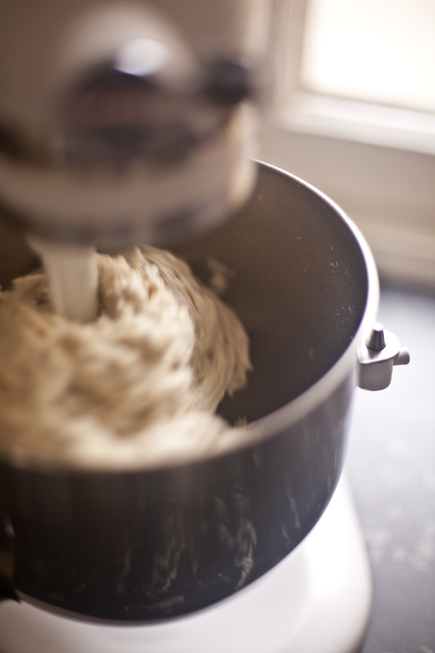
Once all of the liquid is added to the mixer, turn it up to medium-high speed and let it blend for about 1 minute.
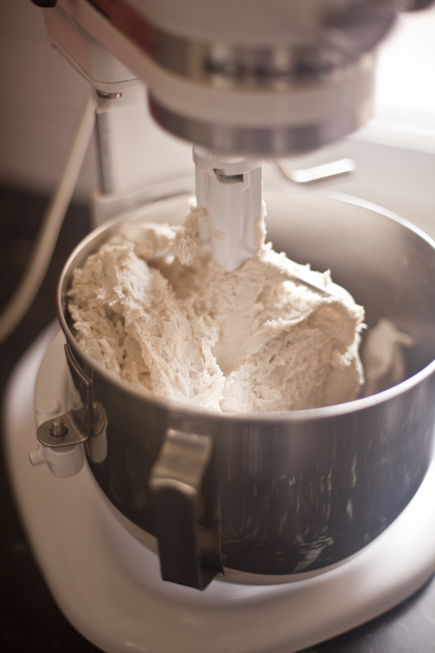
The dough will look and feel like soft biscuit dough.

Transfer the dough to a 4+ quart Food-Storage Container. The dough will rise some, but don’t expect it to double in size.
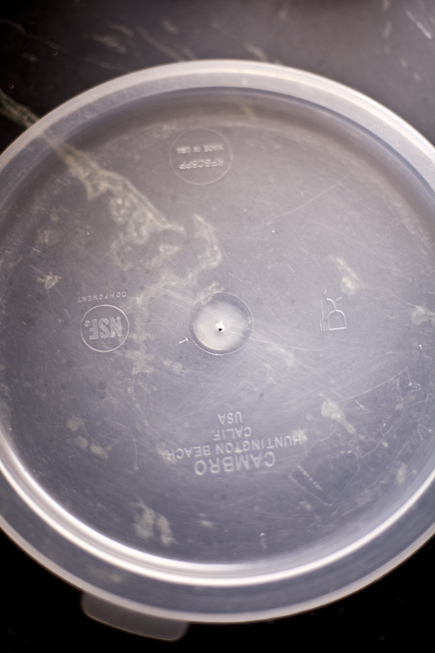
Cover the container, but it shouldn’t be airtight. You may want to poke a very small hole in the lid (you can see it in the exact center of the above lid) to allow the gas from the yeast to escape. If you don’t poke a hole…
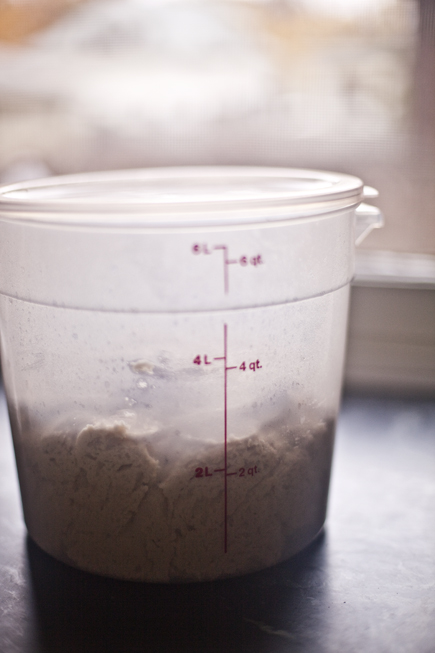
…then you will want to place the lid on the container, but don’t snap it all the way shut (see above photo). Don’t allow too much air to get into the bucket or the dough may dry out.
Allow the dough to sit at room temperature for 2 hours. If your kitchen is cool, it may take 2 1/2 to 3 hours. You can use the dough after the initial rise or refrigerate the dough for about 5 days (10 if you don’t use eggs).
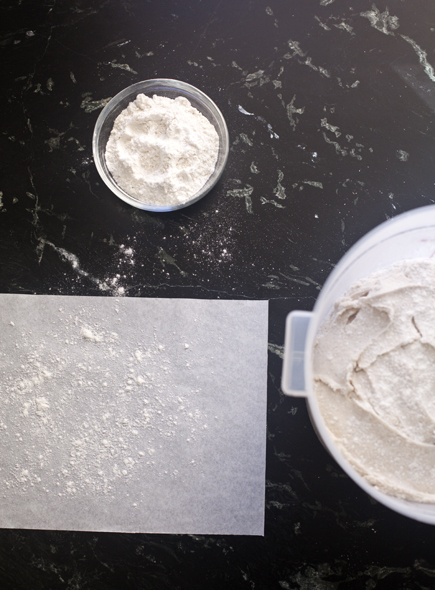
When you are ready to bake, sprinkle some GF flour on a piece of parchment. Dust the surface of the dough with more flour.
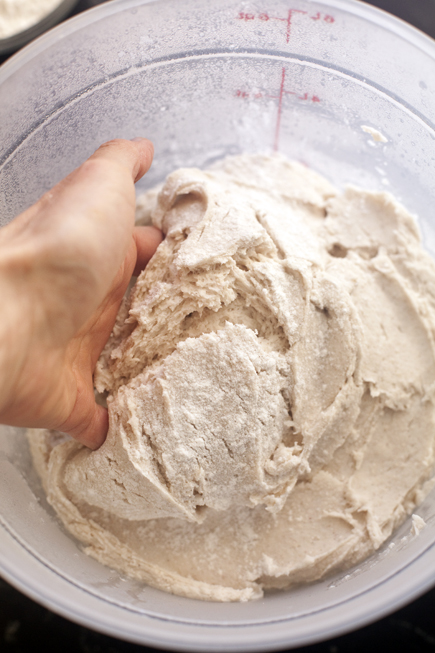
Scoop up a 1-pound piece of dough. Store the rest of the dough in the fridge for up to 5 days if using egg whites, or 10 days if you only used water. That’s where our method saves you time–all your subsequent loaves are made from pre-mixed, stored dough that will develop sourdough flavors as it ages.

Unlike wheat dough, this will not have any stretch when you lift it out, it will just break off.
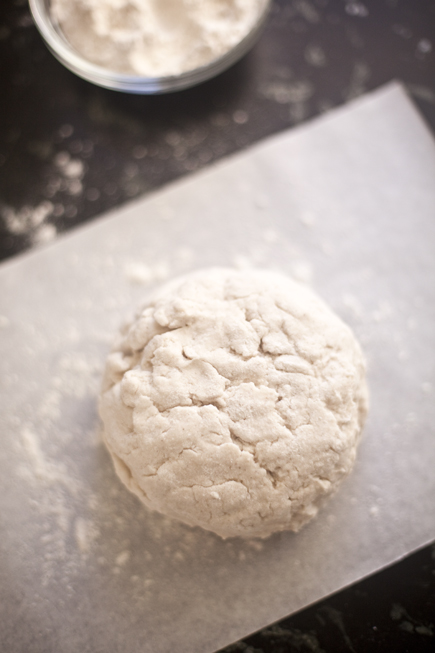
Place the dough on the parchment and shape it into a ball. It may not be smooth at this point.
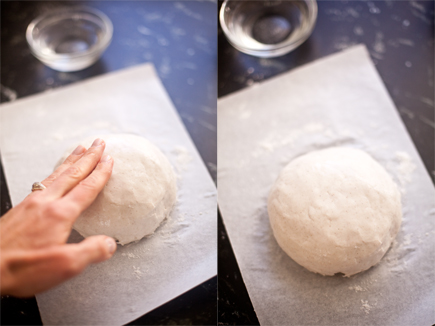
Using wet fingers, smooth out the surface of the dough. Creating a smooth surface also seems to help trap the gas from the yeast and improve the rise of the bread.
Cover loosely with plastic and allow to rise for about an hour. If you are using fresh dough, then just 30 minutes.
Preheat oven with a Baking Stone to 450°F. It is very important that your oven be hot enough, so use an oven thermometer to check the actual temperature. If you are using a thick Baking Stone, this can take 45 minutes or longer. Put a broiler tray on the bottom of the oven, which will be used to catch water to create steam in your oven.
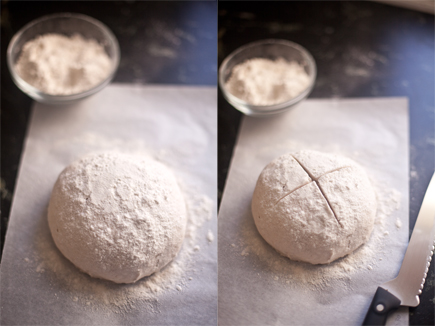
Once the dough is ready (it may not rise much while resting), dust it with more flour and slash the top with a serrated knife.
Slide the loaf onto the preheated baking stone, add 1 cup water to broiler tray to create steam and quickly close the door.

Bake the loaf for about 45 minutes or until nicely browned.

Allow the loaf to cool to room temperature before cutting into it. The gluten-free artisan bread will be quite gummy if you cut into it before it is totally cooled. Using a sharp serrated Bread Knife is the best for cutting this loaf.
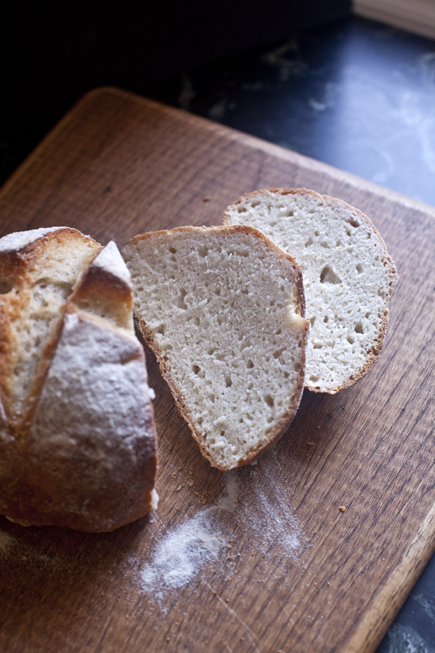
If you don’t finish the loaf in one or two days, wrap it well and freeze it for another time.
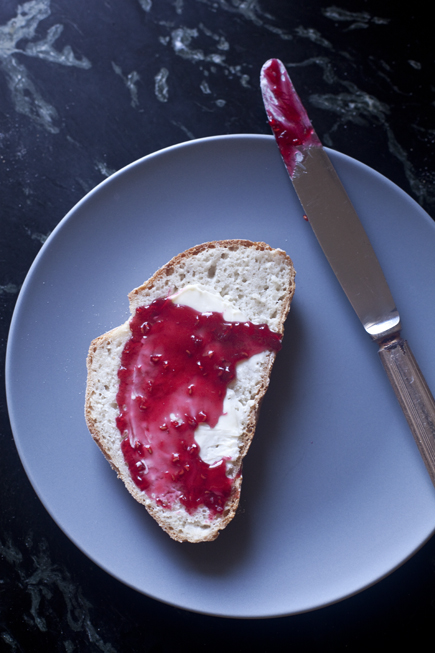
This gluten-free artisan bread also makes wonderful toast the next morning, and you can use up the remaining dough over the next 5 days (if you used egg whites), or 10 days (if you only used water).
See also our Gluten-Free Frequently-Asked Questions.
Note: BreadIn5.com is reader supported. When you buy through links on the site, BreadIn5 LLC earns commissions.
I’ve made the Mixture #1 from the book, then the Master Recipe. Both of the loaves I’ve baked have come out gummy in the center. 1 lb to 1.25 lb of dough, baked as instructed, then once at a lower temp but longer time. Pretty in appearance, nice crust but not edible. I can send photos. Help
Hi Ken,
What binder are you using? Xanthan or psyllium? Are you making any flour substitutions?
Can you eat eggs? If so, did you try the egg white version?
Do you have an oven thermometer? It could just be a matter of temperature and needing more time to bake through. If you make a loaf that is larger than one pound, you will need to let it rest longer and bake longer. If you are baking on a stone, be very sure that it is preheated thoroughly, or it can bring down the temperature of the oven. Baking in a Dutch oven can help with rise and baking as well.
Thanks, Zoë
Zoe – thanks for your reply. Using Xanthan and no flour substitutions. Have no tried the egg white version.
And, I did not bake on a stone, but on a stainless steel sheet with parchment paper, with the cup of water as directed for steam.
An oven thermometer? No, at least not yet. So, I take it that with these results I should simply bake it longer and let it rest plenty of time, maybe 3 hours.
Hi Ken,
Yes, I would bake it a bit longer. It is crucial, especially with gluten-free breads that you allow them to cool or they will seem under baked and gummy.
Thanks, Zoë
Do you suggest any changes to the rest time or cooking if you use a proofer and convection oven to cook with. I usually drop my temp down by 25 degrees but find that in the convection oven that the water does not last. Any suggestions for the amount of water that I should use?
Thank you.
With our very moist GF dough, I worry that convection might crisp and over-brown the outside before the crumb is fully baked. Result might be gumminess. It’s OK if the water “doesn’t last…” The intention there is to create a moist environment in only the first third of baking or so, not the whole duration.
Dropping the temp down might fix my concern about interior under-done-ness.
I made it without egg whites and though I like the flavour, I found it too dense and would like to make a lighter loaf. Could I add perhaps 1 or 2 egg whites to the dough that is already mixed and in my fridge?
Haven’t tried that–given the viscosity of eggs, I don’t think it’ll mix uniformly. Try it with your next batch.
How could I adjust the baking for a dutch oven instead of a baking stone? I’ve seen similar recipes in which the bread is baked lidded for most of the baking time, and then the lid comes off towards the end. Would that work with this recipe?
Hi Hannah,
Here is a post that will help: https://artisanbreadinfive.com/2010/01/05/gluten-free-crusty-boule/
Thanks, Zoë
Hi, I was wondering if buckwheat flour could be substituted in part or parcel for some of the flours in this recipe.
Hi Jennifer,
You could replace some of the sorghum flour with buckwheat or the teff from the Mix #2.
Thanks and enjoy! Zoë
Hi Zoe,
Thanks for the reply. I am using Blend #1. Although I have been using oat flour instead of the sorghum. So if I subbed out some buckwheat flour, would you suggest 1/2 oat and half buckwheat? Have you ever tried the buckwheat? I am rather new to the GF world (not celiac but definitely gluten sensitive). I have found that when I pull off a bit of the dough to make a fresh loaf, I add about another 1/4 tsp of yeast to get a less dense final product. Any tips you can send my way are appreciated!
Hi Jenn,
I have not tried buckwheat in this mixture, so I would start with a small batch and make sure you like the results. It does have a strong flavor, so I’d start out with a small portion and then increase if you like it.
Cheers, Zoe
I’ve made Mixture #1 from the book and am also having problems with a gummy interior. I am also following the recommended size (1 lb to 1.25 lb) and I have let the bread rest for up to double the time recommended, but still no change in the gumminess of the interior. The exterior always looks great, and there is a thick crust, but the interior crumb really needs some help.
Advice on what could be going wrong?
Hi Gail,
Did you try the version with eggs? It tends to be less dense. Are you using xanthan or psyllium? Do you let the bread cool completely before cutting?
Thanks, Zoë
Hi, there! I use Mic #1 as well. I don’t use eggs and I sub out oat for sorghum flour. I have recently started adding just an extra bit of yeast for the rise just before baking. Maybe a 1/4 to 1/3 tsp. I figure the bread had to come to room temperature anyway and I have seen an improvement in texture. Not quite as dense.
Any advice for baking this at 5000 feet?
Check out our faqs page at https://artisanbreadinfive.com/faqs/ and click on the High Altitude question. We didn’t specifically test the GFs at Denver altitude, but the wheat recipes worked fine.
I’ve made this several times and the dough is very very wet. should I cut down the water amount? I am using cup4cup as I do not like mixing my own flour.
Hi Carla,
Unfortunately, I have never had great luck with any commercially available flour blend with our bread recipes, so this will require some experimenting. You can try reducing the water, but I would make small batches until you get a result you like. The closest I have come is with Better Batter brand, but even that required some tweaking.
Thanks, Zoë
I just went out and bought all the recommended flours to try Mix #1. Unfortunately I realize now that I will need 2 bags of Bobs Red Mill Rice Flour and only have one. I have Cassava Flour on hand. Can that be substituted for half of the rice flour?
Hi Nikol,
It really behaves differently, so you are better off just making half the flour mixture with the rice flour you have. If you ever want to experiment with new flours, I suggest you make a small batch, since the flours are expensive and you want to make sure you like the results before you commit to a big batch.
Thanks, Zoë
Hi,
I’m wondering what is the best way to store the bread that I don’t want to freeze?
Which of our books are you working from, and what recipe and page number? I can point you to where we talk about that
Hello there, I’ve used some of your fabulous gluten free recipes like the Brioche for Cinammom buns or the Crusty Boule and love them! But I’m wondering if you have tried any of the Italian Caputo Gluten free flour mixture in any of your recipes? I recently tried making foccacia with it and it was simply incredible! I am just wondering if I can use that in your Brioche dough for instance or would it work for other bun recipes I have?
Hi Roshean,
No, I haven’t but I’d be super excited to know if it works. If you give it a try, I suggest making a small batch, just to make sure you like the results.Please let me know how it goes.
Cheers, Zoë
Hi, I’ve made your master recipe many times and love it! I would like to add dried fruits and nuts to the loaf to approximate a loaf I had before going gluten free. Would this work? Would you add the fruit and nuts to the wet batter or roll it into the loaf when shaping?
Thanks,
Dana
Hi Dana,
That’s wonderful. There are a few breads in the book that are very similar to what you describe. Raisin-walnut oat bread (page 149), Cinnamon Raisin (page 250), Panettone would be a good choice too (page 243).
Hope that helps! Enjoy, Zoë
I have those recipes on my to bake list! The loaf I had though was not a sweet or enriched dough. It was a simple country loaf, so I was wondering if I could use the master recipe?
Hello,
Can you use a chia or flax egg instead of egg whites? If so how many flax or chia eggs?
Which of our books are you working from, and what recipe and page number? Also, go ahead and type the words “flax egg substitute” into our Search Bar above.
Hello! I have difficult time tolerating bakers yeast but do better with wild yeasts. Is there anyway to use your method with a sourdough starter?
Thanks!
Sure, just type “sourdough” into our Search Bar.”
Hi Jeff, I did but all I got were Gluten recipes. Do you have Gluten Free sourdough starter for your GF artisan bread in 5?
I’m afraid we haven’t tested that, sorry for the confusion. It’d probably work, but we’ve never done it. You could try swapping in one of our flour mixtures, but this is going to take a lot of experimentation.
It’s supposed to work. You have to remove the flour and the liquid from the sourdoughstarter from the flour and the liquid of the bread dough. I will try this on my next bread.
I have made this a couple of times using Better Batter, and it has been life changing! The loaves come out great, although a little darker than the pics.
We do have to let them cool completely to avoid them being gummy (learned after tearing into the first loaf too early because it looked/smelled so good!).
On a related note, this dough is also PERFECT for Detroit style pizza!
Very pleased to hear that, thanks for the kind words. and always good to remind folks that all of our recipes need to cool completely or they do seem the way you described. The only exception is (maybe) flatbread and small buns.
Hi there! I accidentally mixed my master GF blend with Sweet white rice flour and not regular white rice flour. I’m also using the Xanthan Gum and water only. The bread does not get a nice brown crust and the inside is extremely gummy. I will make my next loaf and let it cool over night but besides that – any support is greatly appreciated!
Well… you could try working additional flour into the too-wet dough now–but I’m not sure it’s going to help all that much–this flour just didn’t work well in the recipes.
I noticed that the gluten free master recipe on your site does not mention using oil but in Zoe’s kitchen video she adds oil. Is oil needed and if so how much? Looking forward to giving this a go as soon as I can find yeast in my town. Thank you
There are several different recipes. Our preferred recipe these days if from our book that’s entirely devoted to GF, on Amazon at https://amzn.to/1msOBmY, or the recipe here on the website. Seems to work better for most people.
Why are you removing the Egg yolk when it carries more protein then the whites? Just curious on that particular step.
Egg white has slightly more protein (google it). And the yolk tends to weigh things down. No problem to use the whole egg, details in https://amzn.to/1msOBmY
Hi again Zoe & Jeff. I contacted you around Christmas time to ask if the Gluten free Italian flour called “Caputo” would work as a substitute in your Brioche dough. I have used it many times for Pizza and it makes the best Foccacia I’ve ever had bar none. You told me to give it a try and let you know how it works. But because it was for Christmas morning cinammon rolls I was afraid to screw it up, so I chickened out. Now that we’re stuck in quarantine I had some time on my hands. So I tried it this weekend and Wow they were absolutely fantastic!! I highly recommend but I think next time I’m going to try omitting the xanthum gum it’s a bit redundant.
So glad, Roshean! Thank you for letting us know about this.
Can you add additional flour and keep the mix going longer than 5 days?
Yes, see page 73 in the book (https://amzn.to/1msOBmY).
Let me start by saying I have your original book and the healthy breads cookbook and I love them . My brother in law’s girlfriend is gluten free and vegan . Would it be worth it to buy her the gluten free version and what would be your favorite substitute for using no eggs ? Can you use flax egg , or aquafaba , or vegan egg substitute and if so is the liquid one or the powdered one better ? Thank you !
Especially if she’s willing to switch to flatbread, the zero-egg versions in that book work pretty nicely. I have to admit though, that for the loaf breads, it definitely rises better with egg or egg white. The main function of egg in a gluten-free recipe is to improve the rising, and I don’t think that the substitutes do anything for that.
Love your book and have been making a lot of the recipes during our shelter-in-place time. Thank you for putting it together! I have a friend who has a gluten free sourdough starter. Do you have any advice for integrating sourdough starters into the loaf rather than the instant yeast? Any help would be much appreciated.
We haven’t tried GF sourdough, but readers have told us that our basic wheat recipe works, but swapping GF flours. Type “easy sourdough starter” into the Search Bar above. This is going to take some experimentation on your part–we haven’t tested this!
I would ask that you please specify in the instructions when to add the sugar. There is a step that says mix all dry ingredients, but all the other ingredients were called out specifically.
With the salt, I’ve added that to the recipe, thanks.
Hi, I’m making the GF baguette. At what point do I add the yeast (I am using active dry yeast)? Is it just part of the “mix dry Ingredients”? Or do I need to proof it first?
You can go with the dry ingredients; with our method you don’t have to proof (no harm if you want to though, and things will start quicker).
I’m GF and vegan, can I replace the egg whites for olive oil? A lot of bread recipes call for oil to help with the rising, wondering why your master recipe doesn’t call for oil?
Which of our GF recipes are you using (which book and page number)?
I love your book and make many of your breads on a continual basis. When I was diagnosed with Celiac in 2012, I didn’t think I would ever eat a decent slice of bread again.
, I so appreciate the meaning of a good gluten free bread and your recipes deliver.
I would like to know that if I want to make a recipe not from your book, that calls for an all purpose flour blend, do you think I could use the #1 mixture? Thank you for your wonderful recipes.
That’s a reasonable bet, but I have to be honest and tell you that we’ve never extensively tested this. we have tested the opposite situation which is whether the commercial flour blends work in our recipes, and in general they don’t.
I think the fact that other blends don’t work with your recipes is totally understandable, but the other way around, I am leaning to think they will. Only way is to try.
Exactly!
So I made a recipe (not yours) using Mixture #1 as the all purpose flour and it came out fabulous! This is a real bonus.
Hi Suzan,
That’s interesting to know, I’ve never used it beyond our recipes.
Thanks, Zoë
I leave the book and love it! Been baking breads and pretzels for a week straight.
Question- can the pretzels be frozen after baking and cooling? If so, what’s the best way to free and thaw?
Thanks!
Sorry, we missed this one! Sure, but wrap them well in a couple of layers of plastic, or use an airtight container. You should thaw in the same wrapping. (freezing will definitely affect quality here).
Hello, I just ordered the GF book and am excited to get started. Thanks for sharing the recipe and so much information here. I’m baking for a small household, and don’t think we can get through all of this dough in 5 days. Is it possible to freeze the dough? Or do you suggest scaling the recipe down?
Hi KJ,
I would suggest making a smaller batch. One of the challenges with GF bread is that it stales quickly, so I would make smaller batches.
Thanks, Zoë
I’m not sure if you already said this, but another way we’ve saved time with this loaf is to make a huge batch of the flour mixture so that each week, we just have to add the extra ingredients. So… not only is it only 5 minutes a day because all you’re doing is grabbing a chunk of the refrigerated dough, but it also only takes 5 minutes once a week to make the next batch.
Yep, that’s the idea
Hello, The Danish whisk you recommend is no longer available on Amazon. Is there an alternative one that you can recommend? Thank you again!
Hi KJ,
Thank you for letting us know, we will fix that link.
Thanks, Zoe
Hi KJ,
Here is a link to a whisk that I use: https://amzn.to/392UyqV
Thanks, Zoë
My dough didn’t rise much. I added warm water, I placed it on my stove where I had the oven going to give it some warmth and covered it with a towel (my oven light is broken), and so it got adequate warmth. When I took the lid off 2 hours later, it was making a bubbling sound. It smells slightly more sour than yeasty this morning after spending the night in the fridge. I let it rise for 2 hours on the stove covered to keep it warm as its frigid here. But it didn’t double. It rose a little bit but not nearly as much as I thought it would. I added eggs to my water as well. I did replace white rice with brown rice flour and I did replace sorghum flour with oat flour. Now Im wondering if the dough might have been too dry due to the flour swaps? Would a wetter dough lead to a higher rise?
Just to clarify, I put my dough on the stove TOP not in the oven, when I had it rising. I only put the oven on so the heat of the oven would warm the surface ever so slightly to bring a little warmth to help facilitate a rise (as my home is freezing). I often do this to help clabber (ferment) my raw milk and it works beautifully in the winter. Keeps things around 100°. I place towels under to create a buffer to keep it from receiving any direct heat from the surface of the stove from the oven.
And to further clarify, the dough was in a container with a lid.
Hi Nicole,
In general I think this will work just fine for rising dough, but the substitutes with the flour blend are the culprits in a low rising dough. Gluten-free breads are more finicky about making substitutions and you will just have to experiment until you find what you like.
Thanks, Zoë
Hi Nicole,
The swaps you made with change the dough considerably and make a very tight dough, that won’t rise as much. oat flour absorbs a ton of water, so you will likely have to add more water if you swap in more oat flour. Brown rice and white rice also behave differently, so you’ll need to make adjustments for that too. Since you are experimenting with the recipes, I would suggest making half batches until you find the texture and taste you like.
Enjoy, Zoë
Is it possible to use a different starch than corn starch in the buttermilk bread? I’m sensitive to it and can’t use it. Thanks!
Unfortunately we didn’t have good results omitting cornstarch from the recipes–the swaps that worked are on page 61, and as you can see, we didn’t find a good one for cornstarch. You’d have to start experimenting on your own, by increasing the other flours in Mixture #1. Our experience was that texture or flavor were off– but you could probably be more likely to succeed if you do this loaf as a flatbread– much more forgiving.
Love the book! Had the best (perhaps gluten or not) bagels of my life! I live in Switzerland so bagels are anyway unavailable and gluten free anything is hard to come by. Diagnosed celiac in 2013 and have had your book on a book shelf for ages. Finally cracked it open and my world has changed!! I can’t believe it took this long to try the recipes! Just ordered all of your other books and the original for my gf intolerant brother in San Francisco for his birthday
But what I want to know is, can I swap the mix # 2 for the mix # 1 in the master recipe?
Also, I highly recommend using a water bath with molasses for the bagels- total game changer!
Hi Emily,
I am thrilled that you are enjoying the bread.
Mix #2 absorbs water differently than Mix #1, so I would start with a small batch to make sure you like the results. If you try it, let me know what you think.
Cheers, Zoë
Dear Zoe and Jeff,
Thank you for your fascinating book, I’m so eager to get baking! My toddler has a sensitivity to both wheat and potatoes, and I have used a rice flour-tapioca starch-arrowroot starch flour blend in other recipes before with great success. Is there a particular reason you don’t recommend arrowroot starch as a substitution for potato starch in flour blend #1?
Secondly, I would like to do several smaller experimental dough batches, trying out arrowroot and increased proportions of other flours. Would it work to halve or even quater the flour and dough recommendations to try such combinations? I don’t want to make enough flour mix for several batches of dough and each batch able to make several loaves just to find with the first loaf that it hasn’t worked at all! However if there’s a reason why doing it in larger quantities works- proving works better, behaves better in fridge etc then I don’t want to hinder my efforts from the start by portioning into a size that won’t work.
Thank you again!
Hi Lucy,
I always recommend that people start with a small batch of the flour blend and dough when making any substitutions or experimenting with the recipes. You can halve or quarter it. I didn’t experiment much with arrowroot as a substitute for potato, so it may very well work as you suggest. Please let me know if you find a substitute you like, I know other readers will be curious as well.
Good luck, Zoë
Thank you for this recipe and for the master flour mix recipe. I’m wondering once you mix up the actual dough, how many loaves does that make? Thank you!
Hi Hanna,
It depends on what loaves in the book you are baking since they require different amounts of dough, but it makes about four 1-pound loaves.
Thanks, Zoë
Can I bake the 100% whole grain loaf from the gluten free artisan bread in 5 minutes a day, in a loaf pan, instead of a banneton? Thank you.
Hi Teri,
Yes, you just don’t want to make a super large loaf, because the texture on larger, thick loaves can get dense and gummy, so stick to something a bit smaller to start and see how you like the results.
Enjoy! Zoë
Thank you for responding. I will try the 8 1/2×4 1/2″ pan. How long would I cook it and what temp?
Thanks
Hi Teri,
If you are baking the loaf the same day you mix the dough, I would try the trick on page 68 (No rest, no rise, just bake). It may take a little more time to bake in a pan, but just 10 minutes or so. Keep an eye on it. I haven’t tried this with the whole grain in the pan, but I think it will work.
Thanks, Zoë
Hi,
I am very fortunate to have a steam oven. Should I preheat it dry and turn on the steam function when I place the bread in the oven?
Neither of us has one of these, but I’m assuming that the ovens instructions will say whether or not the steam comes on instantaneously. If it does then I think your plan is exactly right. I would try this even if the instructions are vague, and don’t specifically address that.
Can you use the egg version for sandwich bread or just the free-from round?
When you say the “egg version,” I assume you mean either our challah or brioche doughs, and yes–they make nice sandwich breads. The baking directions change of course–as in the recipes for those doughs.
We live at 5,000 ft elevation. Would we need to adjust any ingredients or oven temperature and time using this recipe?
Thank you!
We’ve tested the wheat breads at 5,200 feet, and it doesn’t seem to matter, but haven’t tested the GF there–so you’ll have to do some experimentation.
I would like to make standard sandwich loaves, even using a Pullman pan. What adjustments should I be making?
We didn’t test GF doughs in the Pullman pan because we had some concerns that the moisture really needs to dissipate for this dough, and the Pullman’s cover might prevent that. If you’d like to experiment, type “Pullman” in the Search Bar on the Home Page, and the first two recipes displayed (for wheat-dough Pullmans) will give you pointers. You may just have to increase baking time, and/or remove the cover for the last quarter of baking? This will take some experimentation.
What are the measurements for 1 or 2 loaves
For GF mixture #1
Halving it should be about right
Has anyone had success using this recipe in a bread maker?
Haven’t tried it, but it might work–only concern I have with this very wet dough is that the closed environment of the bread maker might not effectively dissipate moisture and the loaf might be gummy.
Hi
I’m working with the gluten free master recipe from the “new” healthy bread book. I made my first loaf and it tastes ok but looks terrible. I think I did not mix the dough enough. Now that it’s risen can I remix it in the stand mixer?
That would probably knock a lot of the air out of the dough, so I’m not sure I do that. You haven’t said exactly what the problem was in terms of how it looks, so I’m not sure how to advise you. More. Likely you have a shaping problem. Have you seen the video here on the website?
Potato starch appears to be an essential ingredient in your GF master mix #1. We have two family members who cannot have potato starch. The book implies that there isn’t a suitable substitute. What do you suggest? Can I just use mix #2?
There might be a substitute, but I didn’t find it. These recipes and blends are very temperamental when you make changes. When you say that you’re considering using mixture number two, you can, but it’s not a one for one swap with number one. The recipes in the book that call for number two will work, if that’s what you mean.
Are the measurements the same for making dough with the whole grain mixture (#2) as for making dough with #1? I can’t find instructions for using mix #2 ANYWHERE in the book or online.
Mixture #2 appears in seven of the dough formulas in that book (on Amazon at https://amzn.to/3NSJCNM):
European Peasant Bread, page 96 (uses both flour mixtures, mostly #1)
Whole-Grain Gluten Free Loaf, page 99 (uses both flour mixtures, half of each)
100% Whole-Grain Loaf, page 102 (uses all #2)
Seeded 100% Whole Grain Bread, page 106 (uses all #2)
Deli-Style “Rye”, page 109 (uses both flour mixtures, about 1/3 is #2)
Limpa, page 125, and “Pumpernickel,” page 128 (use both flour mixtures, 15% is #2)
Does that help? They’re not interchangeable in recipes; they measure differently, and require different hydration levels.
This is a helpful list. I am allergic to eggs and all these recipes have eggs. Can I use an egg substitute successfully?
I don’t think so, though I haven’t tried. The eggs give lift and rise, and I don’t think substitute will do that.
Trying to bake for someone with gluten, tapioca and potato (nightshade) allergies. Considering cornstarch across the board, but wondering if there are other alternatives?
Thank you.
The only substitutions in my testing that actually worked are found at this page here on the website:
https://artisanbreadinfive.com/2014/10/19/substitutions-for-ingredients-in-our-gluten-free-recipes/
These recipes are more temperamental than wheat-based bread recipes, and I found that they’re very sensitive to swaps. There may be other substitutions that work, but I just didn’t find them. And everything was tested with Bob’s Red Mill GF flours–any others will take different water requirements.
Hey! I’m making “crusty white sandwich loaf ” from page 85 in the GF book… but I want to use the master recipe version with eggs, from page 73… I’m wondering if I will need to adjust the baking time or temp from the crusty sandwich loaf recipe (since that recipe doesn’t have eggs)?
The egg white version shouldn’t need any adjustment to avoid scorching, but the whole egg version might. In that case, decrease the oven to 400F, and increase the baking time a bit. 10% longer?
Just wanted to say thank you! Born and raised in Germany, and therefore used to some of the best bread in the world. found your recipe through a friend and made my first attempt just from the PDF. Ordered the book today after three days of delicious and satisfying bread. my friend from Poland, who is intolerant was in heaven when I gave her one of my Broetchen or rolls. Tip from this novice if you have issues with gummy bread, just make small rolls that really worked for me. Thank you again and happy new year with many more delicious breads.
Jutta, thank you so much for your note here. My time in Germany was one of my favorite bread eating adventures of all. Also, I totally agree with you about small rolls, and flatbreads… Which definitely obliterate any gumminess, even if you have dough that is very well aged. Come back anytime with questions… Jeff